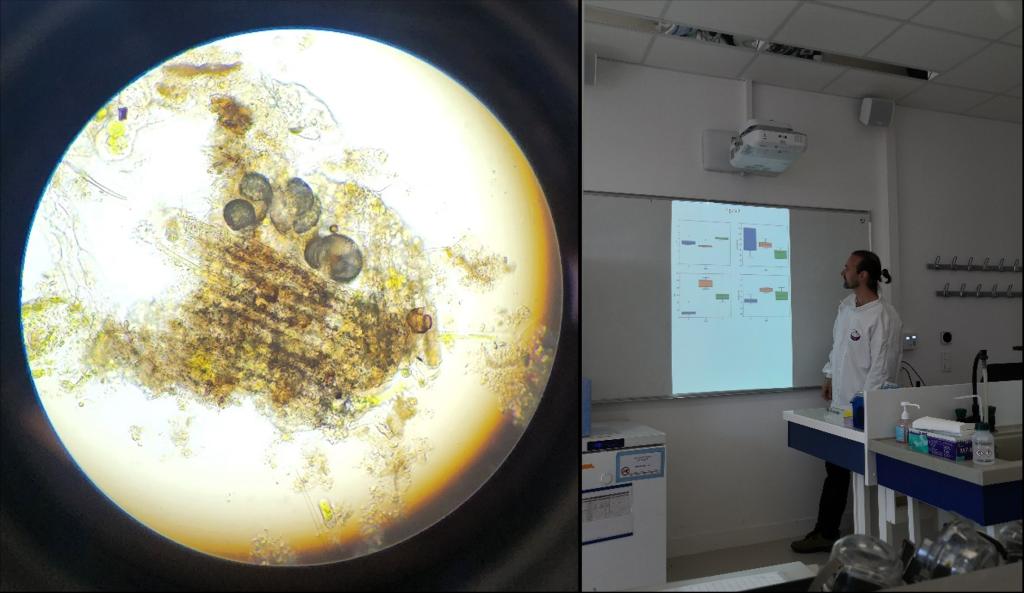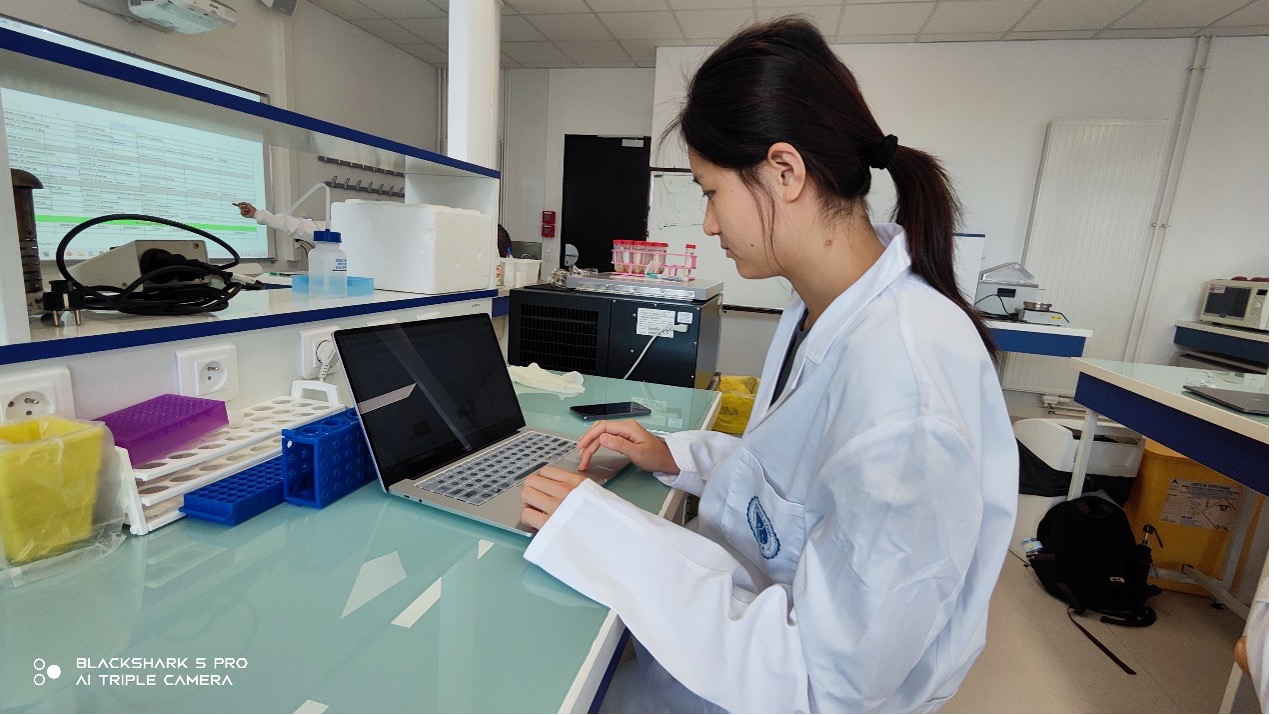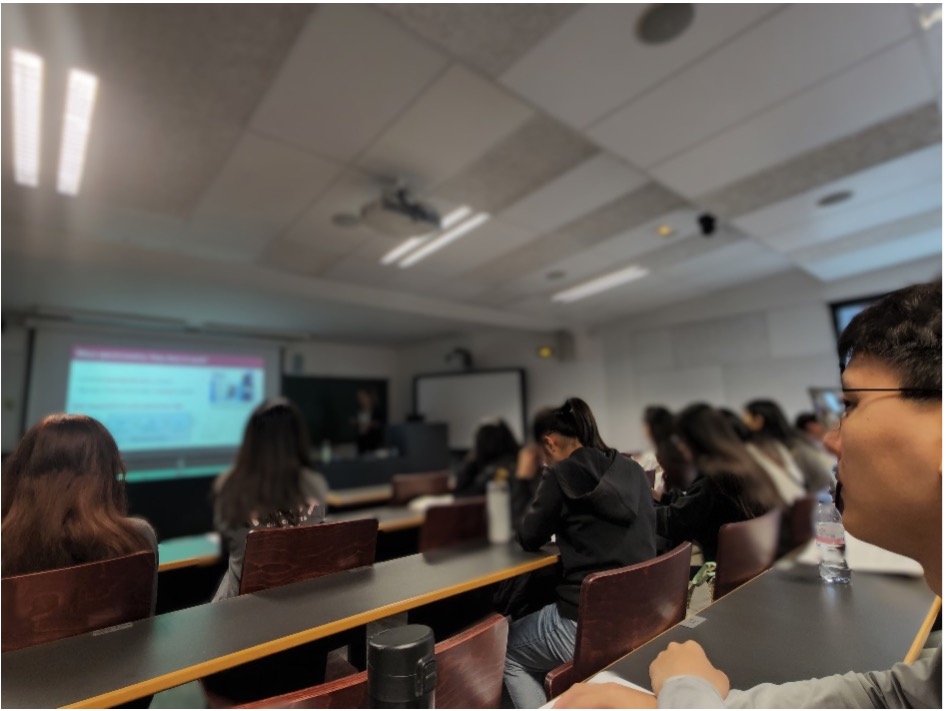记录小组:唐果的奇妙冒险记
组员:孙菓、李嘉卫、张栩、罗斓、李如意、门鑫垚、孙颢宇、王家轩
转眼夏令营时间已过半。在上午的分子生物学实验中,第一次离心后所有试管中都没有明显的DNA沉淀,实验便停滞了。Yanek老师和我们一同讨论,分析原因,并让我们利用接下来的时间鉴定前一天显微镜观察到的微生物种属,同时根据同组成员理化分析的数据绘制图表。在科学实验室探究的过程,当实验过程没有按照预期进行时,我们要认真分析原因并随机应变,充分利用时间而不是面对现状徒伤悲。如同PPEI课的第一条法则,每个问题都有解决办法,如果没有办法,那就说明没有问题。实验的意义并不是得到预期的结果,而恰恰相反,正因为每次的实验结果都不一定与理论相同,才有了探索世界的可能。做实验时也发生了一点小插曲:有个别同学没有摘下实验用手套就去开门。这是很不规范的行为,被老师制止后,我深刻的意识到科学实验本身以及科学实验安全都需要我们保持严谨的态度,在任何细节都不可大意。


当天下午我们前往凡尔赛大学,通过讲座介绍、实地参观、讨论等形式,深入感受这所大学的科研氛围。
首先,Petra Vargic博士介绍了光谱平台的工作原理和应用领域。光谱平台通过分析物质的光谱特征,能够精确地确定其化学成分和结构,广泛应用于化学分析、环境监测和生物医学研究中。这些技术在科学研究中有着重要作用和广泛应用。Aude Jobart-Malfait博士详细讲解了Cymages平台的功能和使用方法,结合显微技术和图像处理技术,对细胞和组织样本进行高分辨率成像和分析,特别适用于细胞生物学和病理学研究。她的讲解使我们对显微技术在生物医学研究中的应用有了更深刻的认识。Syphaxe Zeggane博士对基因组平台进行了全面展示,讲述了其在基因研究中的重要作用。高通量测序技术能够快速、准确地测定生物体的基因组序列,为遗传学研究和基因组医学提供了强有力的支持,这一环节让我们看到了基因组技术在现代科学研究中的前沿地位。

讲座结束后,我们分组实地参观了这些实验平台和实验室。近距离接触这些设备后,我们对显微技术在细胞和分子生物学研究中的实际应用有了更直观的了解,对基因测序技术的前沿发展和实际应用有了更深入的认识。
参观结束后, José Chanes博士进行了题为“果蝇模型:强大的遗传工具”的讲座,详细介绍了果蝇在基因研究中的应用和重要性。果蝇作为模式生物,因其繁殖周期短、遗传背景清晰,广泛应用于遗传学、发育生物学和疾病模型研究。这个讲座让我们了解到了果蝇模型在科学研究中的独特优势和广泛应用。Sébastien Gaumer教授则进行了题为“果蝇揭示HLA-B27与强直性脊柱炎之间的机制”的报告,讲解了最新的研究发现。该研究通过果蝇模型,揭示了HLA-B27基因与强直性脊柱炎之间的分子机制,为理解和治疗这种疾病提供了新思路。这一报告展示了基因研究在医学应用中的巨大潜力。
今天的活动内容丰富多彩,不仅有实验,还有一系列的讲解和参观。我们对光谱分析、基因组学以及果蝇模型的研究有了更深的了解。这次参观让我深刻感受到了科学技术的快速发展和广泛应用,以及科研人员在探索未知领域所付出的巨大努力和智慧。期待接下来的活动能带来更多的知识和启示,为我们的学习和研究提供更多的灵感和方向。
As the summer camp rolls on, we're already past the halfway mark. This morning in our molecular biology lab session, we encountered a setback when no distinct DNA precipitation was spotted in any of the test tubes after the first centrifugation, bringing our experiments to a standstill. Alongside Professor Yanek, we discussed and probed the possible reasons. We were then tasked with identifying the species of microorganisms observed under the microscope the previous day, and meanwhile, we were to create charts based on the physicochemical analysis data from our team members. In the process of scientific inquiry, when experiments don't go as expected, it's crucial to meticulously analyze the causes and adapt, making the best use of our time rather than simply bemoaning the situation. As the first rule of the PPEI course dictates, there's a solution to every problem; if there doesn't seem to be one, then it isn't a problem to begin with. The goal of an experiment does not lie in acquiring expected results but rather in the fact that each outcome may differ from theory, thereby offering the chance to explore the world.
There was also a minor incident during the lab work: some students forgot to remove their lab gloves when opening doors. This is a serious breach of proper lab procedures. When corrected by the professor, I was deeply struck by the realization that both the practice of scientific experiments and the safety protocols demand a rigorous attitude, with attention to detail at every step.
In the afternoon, we headed to the University of Versailles for an in-depth appreciation of the research atmosphere through lectures, field visits, and discussions.
Firstly, Dr. Petra Vargic introduced the working mechanism and applications of the Spectroscopy Platform. By analyzing the spectral characteristics of substances, this platform can precisely determine their chemical composition and structure, therefore widely applied in chemical analysis, environmental monitoring, and biomedical research. These technologies play significant roles in scientific studies. Dr. Aude Jobart-Malfait then elaborated on the functions and usage of the Cymages Platform, which, combining microscopy and image processing techniques, provides high-resolution imaging and analysis of cell and tissue samples, particularly useful in cell biology and pathology research. Her explanation deepened our understanding of the application of microscopy in biomedical research. Dr. Syphaxe Zeggane gave a comprehensive presentation on the Genomics Platform, highlighting its vital role in genetic research. High-throughput sequencing technology rapidly and accurately determines the genomic sequence of organisms, offering strong support for genetics research and genomic medicine, and this session showcased the cutting-edge status of genomics in modern scientific research.
After the lectures, we visited experimental platforms and laboratories in groups. A closer look at the equipment gave us a more intuitive understanding of the practical applications of microscopy in cell and molecular biology research and a deeper insight into the forefront of gene sequencing technology and its applications.
After the visit, Dr. José Chanes delivered a lecture titled "The Fruit Fly Model: A Powerful Genetic Tool," detailing the application and significance of fruit flies in genetic research. Fruit flies, as a model organism, have been widely used in genetics, developmental biology, and disease model research due to their short breeding cycle and clean genetic background. This lecture highlighted the fruit fly model's unique advantages and broad applications in scientific research. Professor Sébastien Gaumer followed with a report entitled "Fruit Flies Unveil the Mechanism Between HLA-B27 and Ankylosing Spondylitis," discussing the latest research findings. Using the fruit fly model, this study revealed the molecular mechanism between the HLA-B27 gene and ankylosing spondylitis, offering new insights for understanding the pathogenesis of this disease and developing novel treatments. This report demonstrated the immense potential of genetic research in medical applications.
Today was filled with a rich array of activities, including experiments, lectures, and visits. Our knowledge of spectral analysis, genomics, and research involving fruit fly models has significantly deepened. This visit profoundly impressed upon me the rapid advancements and wide application of science and technology, as well as the immense effort and intelligence that researchers invest in exploring the unknown. I look forward to the upcoming activities that will bring more knowledge and insights, providing further inspiration and direction for our studies and research.